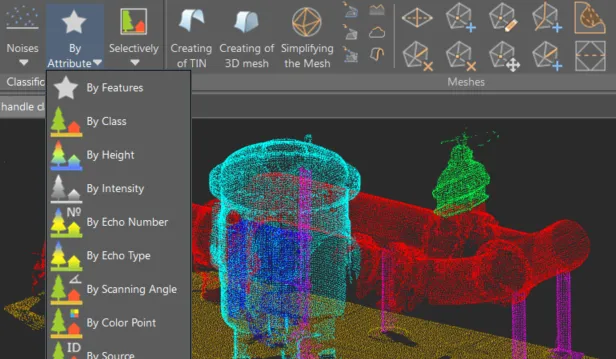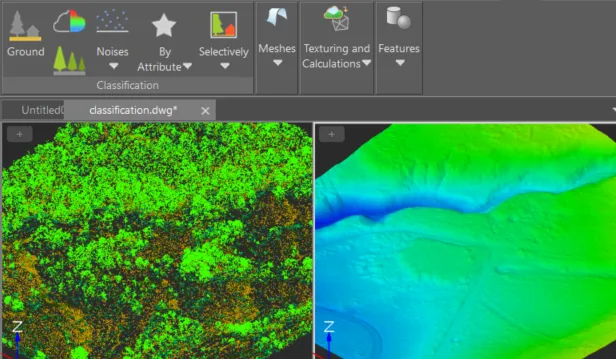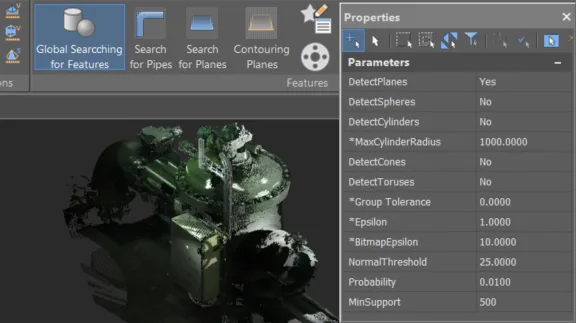nanoCAD 3DScan is specialized software for processing 3D scanning data, addressing engineering and informational challenges in fields like geodesy, mechanical engineering, construction, and infrastructure. It offers advanced tools for analyzing and modeling real-world objects.
Vendor
Nanosoft AS
Company Website



nanoCAD 3DScan
nanoCAD 3DScan is specialized software designed for processing 3D scanning data and tackling engineering and informational challenges across fields such as geodesy, mechanical engineering, construction, infrastructure, and metrological monitoring. It operates as a downloadable vertical application on the nanoCAD platform.
nanoCAD Platform as a Base
nanoCAD is a professional-grade CAD platform fully compatible with the industry’s DWG standard. It offers the standard user interface with a wide set of tools for 2D/3D drafting that can be extended with modules specific to the needs of professionals in engineering, architecture, and construction. 3DScan expands the capabilities of the nanoCAD Platform by:
- Simultaneously using ideal vector CAD models and unstructured real-world data;
- Providing a hybrid representation of real-world data with annotations of ideal geometry;
- Enhancing standard CAD geometry with semantics and parameters derived from the real world;
- Enabling the creation of fully specific objects based on real-world information.
3DScan for Laser Scanning Data Processing
Classified, segmented Point Cloud with recognized geometry of pipelines, buildings and structures
Professional Tool for Laser Scanning Processing
3D scanning is in demand in areas where analysis of the shape and placement of real-world objects is required. It's used in design, modernization of industrial facilities, topographic mapping, and assessment of parameters for existing, planned, or under-construction objects, among other applications. nanoCAD 3DScan features a comprehensive suite of data processing tools, expanding the possibilities when working with point clouds and enabling the resolution of nearly any challenge:
- Preliminary analysis and processing of 3D scanning results
- Classification and segmentation of point clouds
- Creation of Digital Surface Models (DSM) and Digital Elevation Models (DEM)
- Layer-by-layer vectorization and floor plan construction
- Detection of basic geometric shapes and complex technological systems
- Area and volume calculations
Where Applicable
Modeling
- Three-dimensional modeling, including simulation;
- Support for Building Information Modeling (BIM).
Design
- Construction and operation of engineering structures, buildings, and communications;
- Design of machines and mechanisms.
Monitoring
- Monitoring the technical condition of facilities, emergency situations, and environmental conditions;
- Inventory and automation of creating digital twins of industrial facilities.
Topography
- Creation of 2.5D drawings and plans, including topographical ones;
- Populating GIS systems.
Supervision
- Modeling transportation tasks;
- Collision detection;
- Author's supervision.
Measurements
- Conducting operational calculations and measurements.
Features
Searching for planes and pipes in the cloud
Tools for searching pipes and planes in a point cloud based on specific parameters
Quality assurance of registration and error control
Monitoring deviations at each point enables assessment of the registration quality. Reference points with significant discrepancies can be excluded or their weights adjusted, followed by a repeat registration.
Ground classification and verification
An algorithm for automatic ground identification, complemented by a ground verification command that allows for manual refinement of automatically classified points.
Registering clouds by reference points
Mutual orientation of multiple point clouds. Registration allows you to find transformation parameters for an arbitrary number of groups of reference points. Two methods are used: pairwise and iterative.
Creating a point cloud from a model
The tool transforms the specified model into a point cloud at a designated density.
Stitching scans by aligning pairs of corresponding points
The command enables manual registration of clouds by selecting pairs of corresponding points on the screen.
Combining a point cloud with a model
The command achieves precise alignment of a point cloud with a reference model when there is only a minimal offset.
Named views
The command saves segments of the point cloud generated by clipping or sectioning tools.
Classification of sections by attribute
A wide set of tools and parameters for automatic classification based on specified criteria.
Classify Vegetation by Height
Classification of points within a specified elevation range relative to the ground surface. An option to classify various objects by elevation from the ground (such as structures, buildings, power line supports, etc.) is also possible.
Reducing the Point Cloud
The command reduces the number of points in the selected cloud, alleviating excess density that can significantly prolong the processing time of large clouds.
Data filtering
Setting up attribute (metadata) and point classes filters for imported files.
Layer-by-layer vectorization
Automatic construction of multiple sections of point clouds at specified intervals, followed by their vectorization and the generation of raster images.
Creation of a 3D mesh
The command performs 3D triangulation of point clouds of volumetric objects by creating meshes. It can be used to triangulate buildings and other surface structures.
TIN Creation
The command creates an irregular triangulation mesh from a point cloud. The resulting mesh consists of edges that form non-overlapping triangles.
Creation and transfer of cross-sections
The command performs parallel translation of any section within the selected viewport, moving it a specified distance forward or backward.
Searching for key lines
The command searches for key lines such as thalwegs, ridges, etc. It can search both within a point cloud and across a surface.
Fitting elementary shapes
A set of commands that creates objects (line, plane, sphere, cylinder) fitted into a point cloud or a section.
Displaying deviations
A display mode for viewing comparison results with the option to configure additional parameters.
Floor plan construction
Creating a vector floor plan from point cloud data, which may include an external scan of a building and scans of its interiors.
Texture overlay
A set of commands that generates textured surfaces based on specified tasks and input data. These commands allow for the application of flat textures, textures from raster images, and textures from a texture atlas.
Pipeline route creation
Visualization and alignment of pipeline segment axes, constructing a unified route as a 3D polyline. It includes automatic calculation and identification of turning points.
Creating objects by features
The command creates three-dimensional vector objects based on recognized geometry within a point cloud.
Surface difference calculation
The command allows for the calculation and creation of a differential surface between two other surfaces.
Mesh editing
A comprehensive suite of tools for editing constructed meshes, including contouring, slicing, classifying, simplifying, gap filling, and mesh cropping.
Global searching for features
The command searches for basic geometric shapes (plane, sphere, cylinder, cone, torus) within a point cloud.
Volume calculation
A set of tools for calculating volumes between a model and a point cloud, within a contour, or between models. It computes the total volume, balance volume, and the amounts of material to be removed or added.
Area calculation
The command is designed to determine the area of a surface section. It calculates both the total area and the areas projected onto planes.
Point clouds comparison
The tool allows you to assess the degree of overlap between two point clouds or between a point cloud and a model.